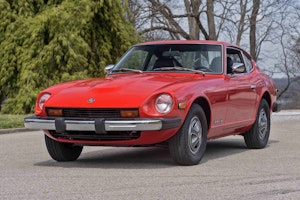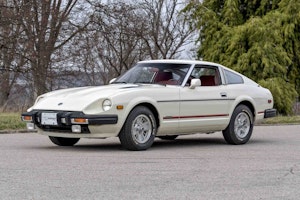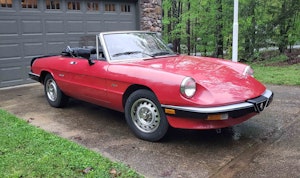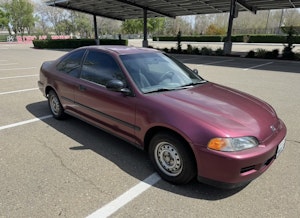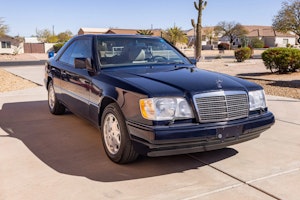Media | Articles
Vellum Venom: 2022 Lucid Air Dream Edition
You likely know someone who will be buying an Atari 2600 in the near future. The buzz around these gaming consoles means it’s only a matter of time before the genre’s influence rivals the likes of broadcast radio. But not all of us pay lip service to Nolan Bushnell’s startup, as we demand arcade quality hardware, ergonomically perfect interfaces, cutting-edge graphics, and sonically stunning audio produced by seasoned experts in the field of interactive entertainment. And it better look the part, with the finest materials worthy of our living rooms festooned with Trinitron TVs, Marantz receivers, and shag carpeting.
No, this isn’t a dream, it’s just 1978 in living color. And here’s a life-changing console for the Atari-averse, with styling that looks the business, including a minimalist polygonal body, smoked plexiglass cover, and gold trim worthy of Studio 54.
The perfect gaming console exists! It is called the Bally Home Library Computer. It is made for folks like us. It’s time to get excited, because the future is now.
Those were the days, as they say. Perhaps you’ve only witnessed Bally’s efforts in home computing via images on the Internet, and perhaps that’s as far as you’ll ever get with the Lucid Air. Both situations are what I’d consider tragic; the Bally and Lucid share beautiful designs with class-leading performance. But we are here to discuss the latter, a super-luxe EV with 1110 hp and 470 miles of range, possessing a Syd Mead-meets-Daft-Punk ethos that’s completely out of this world.
Let’s talk size for starters: the Lucid Air is small—perhaps 1961 Continental small—compared to most swanky luxury sedans today. Lucid said it benchmarked the BMW E39 M5 for performance, and it clearly factored that car’s dimensions into the equation as well. This rig is surprisingly close in length and height to my Fox-body Cougar’s exterior dimensions (proportions notwithstanding).
Marketplace
Buy and sell classics with confidence
Speaking of surprises, the Dream Edition’s wide-open windshield lacks a crossbar between the A-pillars. The lack of a painted structural member in this area (i.e. the lack of a cant rail) lets the user see nothing but big sky, and there is a wing-shaped module for sensors, lights, and the passenger airbag warning light.
These plastic spears adjacent to the one-piece glass windshield/roof prove that you can have a minimalist design and still have provisions for a roof rack to carry your stuff.
The meeting point for both sheets of roof glass has rubber seals that suggest the rear glass is movable. But they are fixed here, so perhaps this flap of rubber is indicative of a future option?
While there are no crossbeams at the A-pillar, the B- and C-pillar have the cant rails needed to keep the Lucid Air structurally sound. But hiding the “cants” behind smoked glass is clever.
The C-pillar’s crossbar is somewhat more conventional, sporting a painted panel over the structural bit. The rubber seal seemingly does double duty as a rain gutter: a nice touch.
Perhaps “conventional” isn’t appropriate for a panel this elegantly tailored around the sheets of glass on the roof and the rear window. Note the hard bend at its ends for necessary surface tension.
The silver hue and radically tapered roof has strong Citroën DS vibes. The light bronze emblem at the base of the C-pillar feels similarly retro, but more in a mid-century Americana way.
It’s nice to see that the hard bend continues into the emblem panel. The emblem panel is an expressive design element that makes a mere emblem rather boring and outdated: with this, an OEM can also throw a splash of color in an unexpected place. Can’t do that with a vinyl decal.
But the coolest part of the Lucid Air’s emblem panel is the whimsical curve added to the leading edge, in stark contrast to the rigid angles at the other three corners.
The integral quarter window takes significant visual bulk out of the C-pillar, thanks to the fact that it touches the rear door glass.
While the B-pillar isn’t made out of transparent glass, the masking effect of the blackout trim is impossible to ignore.
Or is the B-pillar covered in glass, at least to some extent? The recessed camera is a fancy bit of tech, styled elegantly enough considering its wholly-appreciated functionality when inside the cabin.
The A-pillar, unencumbered by a cross bar, is a thing of unadorned beauty. The large blackouts in the glass are not, but perhaps that’s a small price to pay for what’s above.
The glass is cool and tranquil, even in direct sunlight. It’s a fantastic design, and it helps justify the insane asking price ($169,000 for the Dream Edition is close to double the price of the base model.)
These HD cameras are essentially invisible to the casual glance, but work wonders inside the car. This isn’t the last time you’ll see cleverly integrated technology on the Air’s external panels.
Side-view mirrors mounted to the A-pillar (instead of the front door) have been criticized for being inferior from the perspective of wind noise, but this aerodynamic beast (0.21 coefficient of drag) in a beauty’s clothing is dead silent.
Much like a Mini Cooper, there’s a strong band of trim at the base of the DLO. This visually separates the Air’s radical roof from the more conventional body. It also hides exterior features that designers prefer you not dwell on.
Take the wiper blades, hidden under the hood and merely admire the black DLO trim if you are foolish enough to stare at them. Between this and the lack of a plastic filler panel, the Air lives up to its name via styling flights of fancy … even in the most mundane locations.
Speaking of mundane, even this rearward camera sports heating elements to ensure the technology inside is actually usable in icy conditions.
The rear window resembles a visor on a racing helmet, with a little Iron Man mask in that center bump. The massive center CHMSL is encased in a surprisingly large gloss black plastic frame, while the black DLO trim at the bottom completes its loop around the body.
The CHMSL itself is a work of fine crystal; presumably there are red LEDs underneath to complete the look.
Radical roof aside, the Lucid Air still has plenty of design tricks hidden underneath a somber, minimalist style. The expansive silver trim hides both the lighting elements and one of the Lucid’s Lidar sensors. Hiding all that visual bulk under silver trim is beyond impressive from almost every angle.
More visual bulk is removed thanks to negative area, carved out side scoops, and a lower grille that slices into the bumper. The grille does a good job giving the front end a feeling of flight, without resorting to the lumps and bumps normally seen in lower diffusers in vehicles with more sporting intentions. (Even if said vehicles don’t stand a chance against this machine, but that’s beyond our scope here.)
See that sliver of light inside the scoop? That’s all the Air gets (or needs) to create a functional air curtain over the front wheels.
The lower grille’s beginning starts off as a visually confusing pair of bright trim, stacked atop each other to ensure the bumper “rests higher” than the grille beneath it.
Indeed the lower grille rests a bit behind the painted bumper, a fact further accentuated by the thick black frame (much like the base of the DLO) and the long, uninterrupted grille teeth.
While those grille teeth are straight, their contouring catches the light and makes them look curvy from certain angles. Like this one, which is also the perfect shot to show just how much effort Lucid made to hide this bulky Lidar sensor (1 of 2) in a minimalist face.
Right above the sunken lower grille is another excellent use of negative space, this time carving out the painted bumper to give the Lucid Air a modest chin to its smooth, cleanly shaven face. The things within the silver frame are what initially catch your eye, so let’s dig into them.
An array of five LED headlights are deeply recessed in the Lucid’s fascia, further masked by a headlight assembly that uses far more concealing black than it does blingy silver and chrome.
After the five headlights is an amber turn signal (in a similar chrome container) and the amber reflector light. Usually these lights are at the end of the light, but Lucid took a unique path while still ensuring adequate reflections for traffic coming to the Air’s side.
The center grille (as it were) is not unlike that of the Kia Soul, as it serves no purpose other than to visually connect the lighting assemblies into a single pod that stretches from fender-to-fender. But the “furrowed brow” shape of the silver bezel against the black grille feels a bit like the 2013–16 Dodge Dart.
Except this ain’t no Kia, as the center grille masks the presence of a front camera, and the stonkingly-huge Lidar sensor. Having this assembly both recessed from the bumper and finished in black makes it almost disappear upon casual observation.
The Lucid emblem is back lit, presumably using the same LED lights that make the “down the road graphic” you see in the title image of this article.
Even with cooling ducts, the Air’s hood has the same effortless swagger as the massive windshield. All credit goes to the clamshell hood, which pushes its cutlines further down the body. What works for the aforementioned Soul also works on something roughly seven times the price!
The scoops are functional, but only when necessary: note the functional venting, with a door flapper in the front fascia can usually remains closed.
Speaking of solid, the sheer volume of black coverings around the frunk looks both monolithic and like muscular extensions of other lines present in the Air’s design (most notably the contouring around the wheel arch).
Even the frunk’s form matches the silver bezel’s “stick your nose out” demeanor.
And what a nose this is! I am almost knee-deep in the Air’s frunk, a feat hard to match elsewhere.
If I spent that much time and money making an epic frunk, I’d have a chrome emblem showing it all off too.
Even the hood’s honeycomb internal reinforcement is a cool, quirky, and unexpected treat.
Close the clamshell and the cutline is a natural extension of the headlight’s top contour, which is a clean and seamless integration.
Somehow, thanks to minimal use of cutlines, and elegant proportions, the Lucid Air also gets away with painting a body in both silver and gold tones. An astounding feat for color theorists. (I vote for pink and purple on the next limited edition!)
Note how far down the clamshell goes from this angle, as the Air’s fender is downright tiny!
Much like the excellent use of black trim to hide features on the front fascia, the black lug nuts on these 21-inch wheels let the directional geometry move with more implied speed, even without the five zoomy wheel covers installed for maximum aero.
Here’s a shot of the Lucid’s air curtains from the back side: very prominent and yet quite small in surface area.
The silver trim ends nicely around the wheel arch, which is also finished well in slick black plastic.
In a monumental testament to space efficiency, the driver’s side charging port door takes up most of the dash to axle space. Normally this is not a cause for celebration, but somehow Lucid pulled such acts of space efficiency off without looking like a cheap commuter car.
The charging door slides out of the way, while two LED lights ensure you can see the area around you, and the charging port itself.
The Air’s door handles present themselves in a matter less dramatic as the Tesla Model S, but they will quickly open and close to taunt would-be thieves who lack the necessary credentials (i.e. smartphone app or access card) to enter. I grabbed the handle when it went into taunting mode, and it went limp and non-functional to avoid someone breaking them in frustration. Sweet.
The front door is pretty huge relative to the modest dimensions of the entire vehicle, but looks smaller thanks to clever use of negative area (i.e. shadows present in the photo). What’s not cool is the A-pillar’s rake being steep enough to smack your forehead upon entry. Sometimes beauty comes with a side order of pain.
The rocker panel’s implementation of negative area mimics that of the bumper’s lower grille. It’s a fantastic callback, worthy of an episode of Arrested Development (a show that likely had the most callbacks per episode).
And just like the bumper’s lower grille, the rocker panel’s black trim is recessed from the painted surfaces.
And it continues along the doors, terminating at the rear door. Again, that extra bit of brightwork atop the curve is frustratingly logical yet somehow annoyingly superfluous.
While the front door looks taut and perfectly in sync with the A and B-pillars, something about the rear door looks a bit portly and overtly elongated.
Perhaps the door cutline isn’t ideal, but it’s seemingly an accepted principle to have a door cutline somewhere in the middle of a B-pillar instead of at the beginning or end.
Side note: all the weatherstripping in the Lucid Air looks is elegantly designed and provides an eerily quiet cabin, even with that huge windshield.
The end of the C-pillar, the end of the rear door’s glass and the end of the rear door itself (i.e. the painted part) all “end” at different points. Far from a dealbreaker, but having one or two less engine points via cutline integration would tighten up the design.
Maybe just make the painted and glazed surfaces of the rear door share the same line? Preferably the line for the glass?
Considering the external cutlines have no correlation to passenger access when the rear door is open, consolidating the exterior lines would certainly be appreciated.
And if both halves of the door used the same cutline, the shared line of the C-pillar and the deck lid could truly shine.
The long wheelbase, short front/longer rear overhangs, speedy A-pillar and Continentally French C-pillar shouldn’t work together this well. But the Lucid Air succeeds where the aging Tesla Model S fails; it’s something new, but more importantly it’s richly designed and universally appealing.
Like most high end metal, the Air’s proximity sensors have a flush fitting bezel that sucks inward to a vertical plane where the sensor itself can happily do its job.
Unlike the front bumper, the rear’s implementation of a negative area carve out at the bottom is marred by the need for another cutline above (between the bumper and the quarter panel).
Considering the relative cleanliness of the front bumper’s negative area, there’s a lot more to process at the rear.
Somehow, yet again, Lucid got away with slapping two oddly sized trim pieces together. They made it work, perhaps its the fact that each trim panel represents a different level of topography. Or perhaps only because only a tech company can get away with this?
While the front bumper only had one level of shiny black plastic (the other level was actual negative area for the grille), the rear bumper has two. (One to match the painted bumper, the other to match the matte plastic below.)
Even the painted bumper has a hard bend, adding another layer of complexity to the other hard bends below it.
Things get pretty simple as you turn the corner, pass the reflectors/sensors, and reach the center of the negative area: a simple reverse light is all you get for that trouble. Gimme some bright dual exhausts for that eleven hundred horsepower woot woot woot!
Think fast: Is the Lucid Air a hatchback, sedan, crossover, or crossover coupe? Hard to know for sure, which ensures everyone has a tough time pigeon-holing this design. Doing so makes it all things to all people.
Surprise! It’s a sedan with a conventional trunk! And by conventional, I mean a 1930s style bustleback with an Audi Q5-style wraparound design. Brilliant!
From this angle the throwback, bustleback look comes into focus. This is almost as unique as that radical windshield.
Just like the Audi (or any other vehicle with lighting pods on a swing-out door), a set of redundant lights go to work when a Lucid Air owner hauls their own oversized shaped box.
Close the truck back down and enjoy the long, elegant lighting pod with integral heckblende.
Aero precedent set: There’s an integral dovetail spoiler, not unlike that of the 1983–86 Ford Thunderbird.
The decklid’s side marker/reflector light is a gentle reminder of who makes this car, and is the genesis for another bit of silver trim.
The textures in the black plastic keep this part from becoming exceedingly cheap/dull for such a high-dollar luxury car.
Follow me ’round the bend, but notice just how sunken in the light assembly is relative to the deck lid.
The chrome letters keep the Lucid Air’s light panel from looking too much like a Porsche Taycan.
Just like the silver trim around the headlights/grille, there’s a topography change to keep things a bit more visually exciting.
And then there’s another silver topography change as we near the Lucid Air’s rear centerline.
Like sheets of paper falling to the ground, the lighting pod’s internal guts flow along the same line as the silver’s aforementioned transition. It’s a nice touch, again helping differentiate the Lucid from the Taycan.
Below the heckblende is a slightly buck-toothed recess for the license plate frame. It does not “whirl around an April moon” like that Sting song, but it certainly is “whirling in an arc of sadness.”
Perhaps it looks a big glum, but that arc does a fantastic job hiding lights, cameras, and an action button for the trunk popper.
While it’s sad there must be so many cutlines (two in the trunk, one between the bumper/quarter panel) from this angle the Lucid Air has a Cubist feel not unlike the work of Georges Braque.
Cubism and other hoity-toity design references won’t move the metal for a startup automaker, but the Lucid Air’s stunning attention to detail, revolutionary chassis’ hard points (which make small car with a huge interior), and its uncanny ability to blend old and new car design elements has a lot of potential for attracting customers.
It’s pretty clear that even with the emblem, Lucid had a theme in mind. You expect a car with this level of understated style to coddle and cradle you in the finest trim and technology available for a luxury car. You might even expect it to ride as well as an older car with a much softer suspension and tall whitewall tires. (Because it kinda really does, no kidding!) But the Jetson’s space age logo on the decklid cannot prepare you for acceleration courtesy of 1100 horsepower from two fast-spinning electric motors.
It’s all just too good to be true for a first-time automaker, and yet here we are. Thank you for reading, I hope you have a wonderful day.




